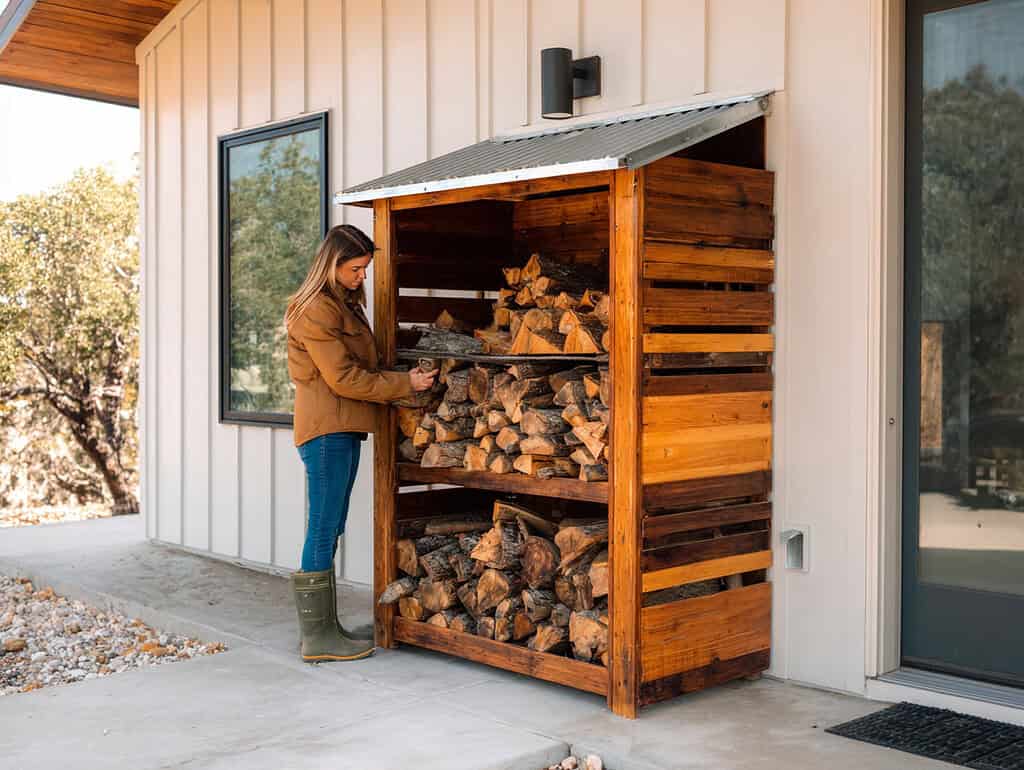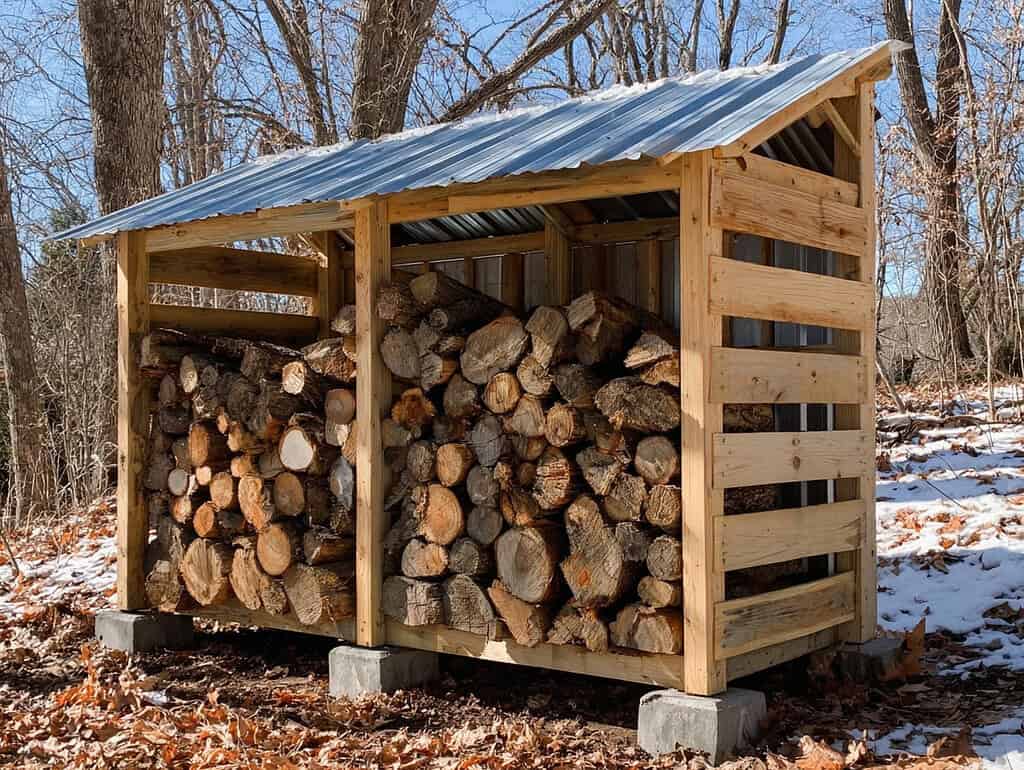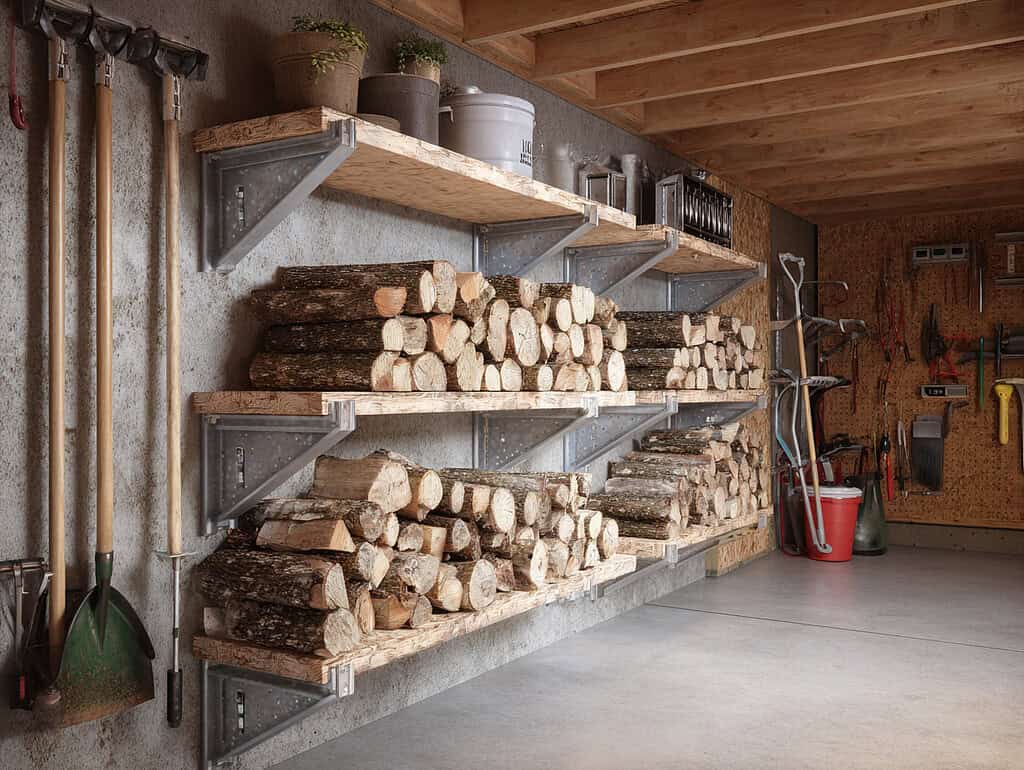Improper firewood storage can lead to damp logs, pest infestations, and wasted resources.
Termites, ants, and rodents are often drawn to unprotected woodpiles, especially when wood is stacked directly on the ground or too close to buildings.
On top of that, exposure to rain and snow can cause your firewood to rot or become moldy.
In this article, I'll share practical firewood storage ideas that not only keep your logs dry and organized but also help prevent pests from turning your woodpile into their next home.
Whether you have a large yard, a small patio, or an indoor fireplace, you’ll find smart solutions that work with your space, budget, and DIY skill level.
What Attracts Pests to Firewood (and How to Prevent It)

Firewood attracts pests because it provides the two things they need most: shelter and moisture. Stacked logs create dark, tight spaces that are ideal hiding spots for insects and small animals.
If the wood stays damp – either from rain or ground contact – it becomes even more attractive to termites, ants, and rodents.
Over time, these pests can migrate from your woodpile to your home, leading to infestations that are costly and difficult to remove.
Here are the most common reasons pests are drawn to firewood:
- Stored directly on the ground: Soil moisture soaks into the wood and creates a damp, rotting environment perfect for insects.
- Improper stacking: Tightly packed or poorly stacked wood traps moisture and blocks airflow, encouraging mold and decay.
- Close proximity to the home: Storing firewood against your exterior wall gives pests a direct path indoors.
- Lack of covering: Uncovered wood absorbs rain and snow, making it more likely to rot and attract wood-boring insects.
To prevent these problems, follow these guidelines:
- Keep it elevated: Use a rack, concrete blocks, or pallets to raise the woodpile off the ground.
- Ensure airflow: Leave small gaps between logs to allow air circulation and speed up drying.
- Store it away from buildings: Keep your stack at least 7 meters (about 23 feet) from your home to create a buffer zone.
- Use seasoned, dry wood only: Fresh-cut or green wood holds too much moisture and can attract more pests.
By controlling moisture and keeping your storage space clean and well-ventilated, you significantly reduce the chance of pest problems – whether you store firewood indoors, outdoors, or in a shed.
Looking for natural ways to keep bugs out of the garden too? Check out these best natural garden pest control solutions for simple, non-toxic options.
Essential Firewood Storage Principles (Applies to All Types)
No matter which firewood storage method you use, a few core principles must always be followed to keep your wood dry, safe, and pest-free.
These practices are simple but make a major difference in how well your firewood burns and how long it lasts.
1. Elevation
Firewood should never sit directly on the ground. Soil moisture seeps into the bottom layer, leading to rot, mold, and a high chance of insect infestation.
Use a firewood rack, wood pallets, or concrete blocks to keep the stack raised at least several inches off the ground. Elevation also improves airflow underneath the pile, helping it dry faster.
2. Ventilation
Good airflow is essential for seasoning firewood and keeping it dry during storage. Wood that’s tightly stacked or wrapped in plastic traps moisture, which encourages mold and attracts pests.
Always leave space between logs, and make sure the sides of your woodpile are open to let air move freely.
3. Covering
Protect your firewood from direct rain and snow, but don’t seal it off entirely. The best method is to cover only the top of the stack using a tarp, sheet metal, or wooden roof.
This keeps moisture off the logs while still allowing airflow through the sides. Avoid wrapping the entire pile or using plastic sheeting, which traps moisture and leads to rot.
4. Stacking
Stack your firewood neatly with slight gaps between each log to encourage air circulation. A stable stack also prevents collapse and injury.
The crisscross or Holz Hausen method is especially effective – it forms a round or spiral structure that dries wood more evenly and adds visual appeal to your yard.
5. Distance from Your Home
Keep firewood stored at least 7 meters (23 feet) away from your house or any other building.
This helps prevent termites, ants, and rodents from making their way from the pile into your walls, attic, or basement. Even if your firewood is dry and clean, it’s better to store it at a safe distance.
By applying these five principles to any storage method – shed, rack, or shelf – you protect your firewood investment and reduce the risk of unwanted problems.
Thinking about adding a small structure to store wood or double as a garden retreat? You might love these cheap she shed ideas for inspiration.
10 Smart Firewood Storage Ideas to Keep Your Woodpile Pest-Free
Choosing the right firewood storage depends on how much wood you need to store, how much space you have, and whether you want a permanent or portable setup.
Each of the ideas below follows the core principles of elevation, airflow, and pest prevention, while also offering practical and design-friendly solutions for a variety of settings.
1. Dedicated Firewood Storage Shed

A firewood storage shed is one of the most effective long-term solutions for keeping wood dry and pest-free.
Built as a standalone structure, it shields firewood from rain and snow while allowing airflow through slatted walls or open sides. Elevating the floor with concrete blocks or treated wood helps prevent ground moisture from seeping in.
Many sheds are designed with two compartments – one for seasoned wood, one for drying – and a small shelf for kindling.
If building your own, choose a plan that includes proper ventilation and a roof with enough overhang to protect the stack.
With the right setup, a firewood shed keeps your wood dry, organized, and ready to use year-round.
2. Wall-Mounted Firewood Holders (Aesthetic & Space-Saving)

Wall-mounted firewood holders are a practical option for storing small amounts of wood near a fire pit or fireplace. They keep logs off the ground and neatly stacked while saving floor space.
These holders work well both indoors and outdoors, especially when mounted on fences or walls close to where the wood will be used.
Some designs include multiple sections for sorting by size, and styles like the honeycomb shape add a decorative element to your space.
To ensure safety and stability, always use proper wall anchors and choose a location where the wood can stay dry and get some airflow.
3. Built-In DIY Firewood Storage Shelves

Built-in firewood shelves are integrated directly into your home’s layout, often placed around a fireplace or along a wall.
They turn stacked firewood into a visual feature while keeping it close at hand. Narrow open shelves are best, allowing air to move through the stack and keeping the wood accessible.
This type of storage works well in modern or rustic interiors. Many DIYers create built-ins using IKEA bookshelves or simple framing lumber.
As long as the wood is fully seasoned and stored off the floor, built-in shelves offer both function and design appeal.
4. Customizable Rack Bracket Kit (Easy DIY)

A rack bracket kit is a simple solution for building a sturdy firewood rack without advanced woodworking skills.
The kit includes metal brackets designed to fit standard 2x4s, allowing you to customize the length and height based on your available space.
The result is a stable U-shaped rack that holds wood off the ground and allows airflow around the stack.
This setup works well both indoors and outdoors. Use longer 2x4s for larger outdoor storage, or shorter ones for a compact rack by the fireplace.
It’s a flexible, budget-friendly option for anyone who wants a functional firewood rack without starting from scratch.
5. Repurposed Wood Pallets

Using wood pallets is a cost-effective way to build a firewood rack while reusing materials.
Pallets can be stacked or joined together to create a base and back support for firewood, keeping it elevated and organized. Before using them, sand any rough edges and make sure they’re stable.
Only use pallets marked with an “HT” stamp, which means they’ve been heat-treated and are safe for home use. Avoid those marked “MB” or with no markings at all.
Once assembled, cover the top of the stack with a tarp or roofing panel to keep rain off while leaving the sides open for ventilation.
6. Modern Metal Rack (Fabricated or Pipe DIY)

A modern metal rack offers a clean, minimal look that fits well in covered outdoor areas like porches or patios.
These racks can be custom-made by a metal fabricator or built at home using black steel pipe and elbow fittings. Either option creates a sturdy, elevated structure that keeps firewood neatly stacked and off damp surfaces.
This style is best placed in a location protected from direct rain, since metal doesn’t absorb moisture but the wood still can.
It’s ideal for homeowners who want a sleek appearance while maintaining good airflow and pest protection around their woodpile.
7. Floating Hearth Storage

Floating hearth storage makes use of the empty space beneath a raised fireplace hearth.
It’s a space-saving solution that works well in smaller homes, keeping a modest amount of firewood close to where it will be used.
The wood remains visible but contained, helping maintain a clean look indoors.
This method is best for seasoned wood that’s already dry, as indoor spaces generally don’t allow for much airflow.
As long as the wood is clean and fully cured, storing it under a floating hearth is both functional and efficient.
8. Narrow Outdoor Firewood Rack (For Tight Spaces)

A narrow outdoor rack is ideal for small yards or side areas where space is limited. These racks are often placed along fences or walls and built using pressure-treated 2x4s with a simple frame.
A small overhang or corrugated roofing panel can be added to keep the top of the stack dry.
Leave a few inches of space between the rack and any wall or fence to allow for airflow and prevent moisture buildup.
Always keep the rack at least 7 meters (23 feet) from your house to reduce the risk of pests traveling indoors.
9. Multipurpose or Tabletop Racks

Multipurpose racks combine firewood storage with other uses, such as serving as an outdoor table or general utility rack.
These are especially useful on patios or decks where space is limited and function matters. A tabletop rack can hold logs underneath while offering a surface for food or drinks during gatherings.
Many designs include interior shelving (often in triangular or angled shapes) to help distribute weight and improve stability.
When using this type of rack, avoid overloading it and check that the frame remains balanced, especially on uneven surfaces.
10. Cantilever Garage Shelves (Use Vertical Space)

Cantilever shelves in the garage are a smart way to store firewood without taking up valuable floor space.
These shelves are mounted directly to the wall and can be adjusted in height to hold different log sizes.
By lifting the wood off the ground and organizing it vertically, you free up space for other tools or supplies (especially helpful if you’re already using the wall for things like garden tool storage).
Make sure the shelves are securely anchored and built to handle the weight of firewood. It’s best to use seasoned, dry wood only, as green wood is heavier and more likely to cause structural strain.
Avoid stacking too high, and leave room between logs for ventilation to keep the wood dry and ready to use.
Start Storing Firewood the Right Way
Storing firewood properly doesn’t have to be complicated, but it does require a bit of planning.
Whether you choose a shed, rack, shelf, or a multipurpose setup, the key is to keep your wood dry, elevated, and well-ventilated.
This not only prevents pests and rot but also ensures your firewood burns efficiently when you need it most.
Pick the idea that best fits your space, usage, and budget, and set it up with the core storage principles in mind.
Already tried one of these methods or have a setup of your own? Comment down below and share what’s worked best for you!
FAQs
How long should firewood dry before storing it for use?
Firewood should be dried (or seasoned) for at least 6 to 12 months, depending on the wood type and climate. Hardwoods usually take longer than softwoods. You’ll know it’s ready when it’s lighter, has cracks at the ends, and sounds hollow when tapped.
Is it okay to store firewood under a deck?
It’s not recommended. Storing wood under a deck can trap moisture and invite pests close to your home. If you must store it there, keep it elevated and well-ventilated, and never stack it directly against the structure.
Can I store firewood in a plastic container or bin?
No. Plastic containers trap moisture, which leads to mold and rot. Firewood needs airflow to stay dry. If you want to cover it, only cover the top and leave the sides exposed.
How often should I rotate or restack firewood?
If you're drying freshly cut wood, restack it every few months to improve airflow. For seasoned wood, no rotation is needed unless you notice dampness or mold forming.
What’s the best surface to place a firewood rack on?
Gravel, concrete, or pavers are ideal surfaces. They drain water well and help keep the base of the rack dry. Avoid soil or grass, which retain moisture and attract pests.
